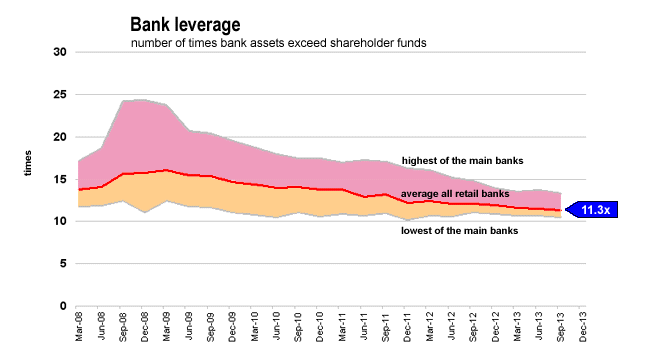Leverage at the country's major banks, or the number of times assets exceed shareholder funds, is down to its lowest level since interest.co.nz started tracking it in March 2008.
The weighted average leverage ratio across ANZ Bank New Zealand, ASB, BNZ, the Co-operative Bank, Kiwibank, Rabobank NZ, SBS Bank, TSB Bank, and Westpac NZ was 11.3 times as of September 30. That's down from 11.5 times at June 30.
The lowest individual leverage ratio is Rabobank's 9.1, down from as high as 26 in June 2010. Kiwibank's 17.7 is comfortably the highest.
Among the big four Australian owned banks ANZ has the lowest leverage ratio at 10.5, and BNZ the highest at 13.2.
| Bank | Leverage ratio |
| ANZ | 10.5x |
| ASB | 12.8x |
| BNZ | 13.2x |
| Co-operative Bank | 11.3x |
| Kiwibank | 17.7x |
| Rabobank | 9.1x |
| SBS Bank | 12.6x |
| TSB Bank | 12.2x |
| Westpac | 10.7x |
| Weighted average | 11.3x |
All figures above are as of September 30.

This article was first published in our email for paying subscribers on Monday morning. See here for more details and to subscribe.
6 Comments
Good to see Kiwibank aggressively growing its book , even if there are risks, I am sure the risk managment systems are robust .
Hopefully its all or mostly secured lending .
And God help us if it those Aussie banks were as highly leveraged as Kiwibank, they know less about banking in comparison. I think you'll find Boatman, Kiwibank is heavily expossed to a secured lending asset called housing in the 3rd most over valued housing market in the world based upon the report we saw last week...comforting.
and then some doubt the figures used.
It is not widely appreciated but Australia’s four major banks are leveraged 24 to 30 times their capital. This represents the ratio of the dollar value of their assets to their core tier one capital.
http://www.afr.com/f/free/blogs/christopher_joye/rba_quietly_increases_…
The tier one capital ratios quoted in the media are often higher because they assume heavily discounted – or “risk-weighted” – asset values. The Australian Prudential Regulation Authority’s Charles Lattrell says that risk-weighted assets across the major banks are “about 50 per cent” of real asset values. Use of these discounted values understates true leverage.
With actual leverage of roughly 26.5 times, a 4 per cent fall in asset values would, on average, wipe out the major banks’ capital. While the banks are regarded as being durable institutions, it does not take much duress to invoke solvency threats. The Basel Committee’s second finding was that banks should hold more liquidity in the form of high-quality liquid assets to pay out depositors and wholesale bond holders during times of stress.
Almost 60 per cent of Australian banks’ funding comes from deposits. Approximately half of these are at call, the remainder having an average term of six months. The contractual maturity of all deposits is thus less than three months. Almost one-third of other bank funds come from wholesale bonds with an average maturity of about 3.7 years.
Our data does not use the techniques you mention. Our tables make it clear we are 'simply' relating the total shareholders funds to the total assets they are supporting. We are doing this without 'risk weighting' or using any of the BIS / Basel fudges.
Our leverage calcs are the same you would use for any other company and don't include any special banking 'adjustments'.
The Basel Committee’s second finding was that banks should hold more liquidity in the form of high-quality liquid assets to pay out depositors and wholesale bond holders during times of stress.
Not in NZ - the unsecured lenders are the liquidity buffer - depositors and local bondholders. The RBNZ has a lot to answer for institutionalising OBR without a widely publicised declaration of it's intent.
For those interested, here's an article from the Economist explaining the behaviour of banks with regard to leverage ratios. I thought it was rather interesting that bank equity levels change very little and leverage often swings wildly in either direction.
http://www.economist.com/blogs/freeexchange/2013/01/putting-finance-mac…
Given that NZ bank ratios have fallen does that suggest that credit isn't accelerating to the levels we would have thought or have bank payout ratios stabilised or fallen in recent times? A bit of both perhaps?

We welcome your comments below. If you are not already registered, please register to comment
Remember we welcome robust, respectful and insightful debate. We don't welcome abusive or defamatory comments and will de-register those repeatedly making such comments. Our current comment policy is here.